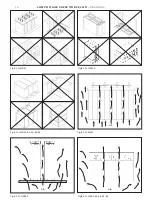
2
Before installation, read this notice carefully and keep
it at disposal of people in charge of installation, main-
tenance and operation.
Read this first
Safety
WARNING!
Wait 5 min. after isolating supply before
handling. As an additional precaution before commenc-
ing work, short-circuit the capacitor terminals with a
piece of insulated cable to confirm discharge.
For a safe use of CLMD capacitor units, please ensure
• Installation and maintenance are undertaken only by
authorized and qualified personnel, in accordance
with current local regulations;
• Isolate the equipment from the supply before at-
tempting to gain access.
Inspection on reception
Unpack the CLMD and check that:
• data on the label correspond to those of your pur-
chase order and local regulations;
• the CLMD is not damaged.
Any loss or damage should be notified immediately
to your closest ABB agent.
Storage
Indoor, in dry, dust free and non-corrosive environ-
ments, protected from vibrations or shocks. Storage
temperature: minimum: -40°C/-40°F, maximum:
75°C/167°F.
Transportation and handling (Fig. #1)
In case severe conditions of transportation are ex-
pected, we recommend that the panel including
CLMD units be positioned in such a way that CLMD fixa-
tion points are at the bottom. For CLMD33/33S, more
positions are allowed.
WARNING!
Failure to respect the installation rules may
lead to premature failure, other material damage to in-
stallations or bodily injury.
Installation
Applicable standards
IEC 60831 Parts 1 and 2. Current local regulations.
Protection
CLMD13, 43, 53, 63 and 83: IP42
CLMD45, 65 and 85: IP54
CLMD33 / 33S: IP40
See capacitor nameplate for IP degree.
Installation and use
Indoor installation on firm foundation or fixed on a
rigid plate/frame in well-ventilated situations where
the air temperature around the capacitor does not ex-
ceed 35°C/95°F over one year, 45°C/113°F over 24 hours
and 55°C/131°F (according to IEC 60831 Parts 1 and 2
for a -25/D temperature category product).
CLMD13, 43, 53, 63 and 83 also exist in outdoor execu-
tion. The temperature class is then -40/D according to
IEC60831. See nameplate for specification. Exposure
to sun may overheat capacitors. Special care must be
taken.
WARNING!
The ambient temperature for capacitors in-
side a cubicle is the temperature around the capacitors
and not around the cubicle.
WARNING!
Like other standard capacitor units, CLMD
discharge devices are not suitable for use with rapid
switching rates (minimum off time: 40“). Additional
external resistors are not a solution for such cases.
Only specially designed capacitors must be used in
such applications.
Vertical and horizontal mounting
The CLMD capacitors must be fixed in such a way as to
ensure a natural airflow from bottom to top.
Minimum free space between units:
• CLMD13: 20mm
• CLMD33 / 33S: 20 mm (25mm for units
≥
30 kvar)
• CLMD43-45, 53, 63-65 and 83-85: 50mm
In case of vertical mounting, use a punched mounting
plate or support bars to allow free airflow between the
capacitors (Fig. #2). Do not mount upside down. (Fig.
#3)
In case of horizontal mounting, install so that the natu-
ral airflow goes between the units (Fig. #4). Do not
mount so that the natural airflow is blocked (Fig. #5).
Installation in a cubicle
WARNING!
Guidelines only apply if the following limits
are respected:
• Maximum room temperature: 40°C (1 hour).
• Average maximum room temperature over 24 hours:
35°C.
• Average maximum room temperature over 1 year:
25°C.
When the capacitors are installed in a cubicle the com-
ponents should be placed in such a way as to optimize
the cooling. Do preferably place devices with high heat
dissipation above the capacitors to avoid overheating
them. When reactors are used they should be placed in
such a way that they do not radiate heat directly on the
capacitors. A thermal barrier is recommended. Reac-
tors do in general dissipate much more heat, so their
thermal impact through convection must also be taken
into account.
1. Natural air circulation
The difference in height between air inlet and air outlet
should be large enough to improve the air circula-
tion. The airflow should be channeled in such a way as
to well cool the hottest spots in the cubicle. Air should
flow from the bottom to the top of the cubicle. The
cross-section of the top air outlet should be at least
equal to 1.2 times the cross-section of the bottom air
inlet.
LOW VOLTAG E C A PACITOR S CLM D -
EN G L I SH
en



































